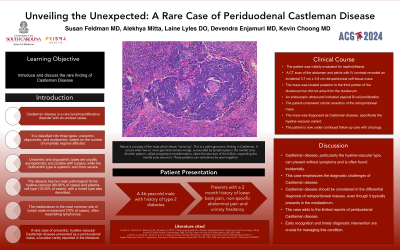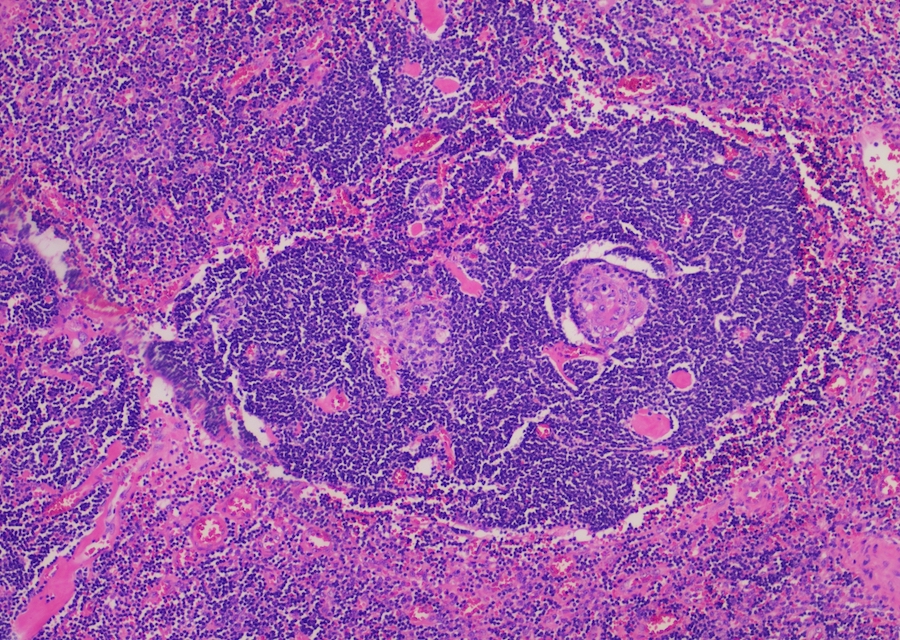Sunday Poster Session
Category: Interventional Endoscopy
P1100 - Unveiling the Unexpected: A Rare Case of Periduodenal Castleman Disease
Sunday, October 27, 2024
3:30 PM - 7:00 PM ET
Location: Exhibit Hall E

Has Audio

Susan Feldman, MD
Prisma Health, University of South Carolina School of Medicine
Columbia, SC
Presenting Author(s)
Susan Feldman, MD, Laine Lyles, DO, Alekhya Mitta, , Devendra Enjamuri, MD, Kevin Choong, MD
Prisma Health, University of South Carolina School of Medicine, Columbia, SC
Introduction: Castleman disease, also known as angiofollicular lymph node hyperplasia, is a rare set of lymphoproliferative disorders with a largely unknown etiology. It is clinically classified as the unicentric, oligocentric, and multicentric types, depending on the number of lymphatic regions affected. The unicentric and oligocentric types are generally asymptomatic and curative with surgical intervention. In contrast, the multicentric type is a systemic and progressive manifestation that gives rise to symptoms of fever, hepatosplenomegaly, night sweats, and weight loss similar to neoplastic disorders. Pathologically, the disease can be described as the hyaline-vascular, most commonly seen (80-90%), and plasma-cell types (10-20%). The mixed type. Although lymph nodes of any region in the body may be affected by this disease, the mediastinum is the most reported presentation in over 70% of cases, often mimicking lymphomas. The least common sites include the cervical, abdominal, and pelvic regions, areas generally only affected in multicentric disease. Here, we report a case of unicentric, hyaline-vascular type Castleman disease presenting as a periduodenal mass, a rare manifestation with limited documentation in literature.
Case Description/Methods: This is a case of a 46-year-old male with a history of diabetes who presented with a 2-month history of lower back pain, non-specific epigastric abdominal pain, and urinary hesitancy. Initially evaluated for nephrolithiasis, a CT scan of the abdomen and pelvis with IV contrast revealed an incidental 3.7 cm x 3.9 cm retroperitoneal soft tissue mass located posterior to the third portion of the duodenum, not arising from the duodenum. An endoscopic ultrasound showed atypical B-cell proliferation. The patient subsequently underwent robotic resection of the mass, which was diagnosed as Castleman disease, hyaline-vascular variant. He continues to be followed by oncology.
Discussion: Castleman disease can present asymptomatically and is often found incidentally, especially the hyaline- vascular type as in our patient. This case highlights the diagnostic challenge posed by Castleman disease. This case also demonstrates the need to include Castleman in the differential of retroperitoneal masses, despite its usual presentation in the mediastinum. In conclusion, this case adds to the limited documentation of periduodenal Castleman disease and underscores the importance of early recognition and diagnostic intervention.

Disclosures:
Susan Feldman, MD, Laine Lyles, DO, Alekhya Mitta, , Devendra Enjamuri, MD, Kevin Choong, MD. P1100 - Unveiling the Unexpected: A Rare Case of Periduodenal Castleman Disease, ACG 2024 Annual Scientific Meeting Abstracts. Philadelphia, PA: American College of Gastroenterology.
Prisma Health, University of South Carolina School of Medicine, Columbia, SC
Introduction: Castleman disease, also known as angiofollicular lymph node hyperplasia, is a rare set of lymphoproliferative disorders with a largely unknown etiology. It is clinically classified as the unicentric, oligocentric, and multicentric types, depending on the number of lymphatic regions affected. The unicentric and oligocentric types are generally asymptomatic and curative with surgical intervention. In contrast, the multicentric type is a systemic and progressive manifestation that gives rise to symptoms of fever, hepatosplenomegaly, night sweats, and weight loss similar to neoplastic disorders. Pathologically, the disease can be described as the hyaline-vascular, most commonly seen (80-90%), and plasma-cell types (10-20%). The mixed type. Although lymph nodes of any region in the body may be affected by this disease, the mediastinum is the most reported presentation in over 70% of cases, often mimicking lymphomas. The least common sites include the cervical, abdominal, and pelvic regions, areas generally only affected in multicentric disease. Here, we report a case of unicentric, hyaline-vascular type Castleman disease presenting as a periduodenal mass, a rare manifestation with limited documentation in literature.
Case Description/Methods: This is a case of a 46-year-old male with a history of diabetes who presented with a 2-month history of lower back pain, non-specific epigastric abdominal pain, and urinary hesitancy. Initially evaluated for nephrolithiasis, a CT scan of the abdomen and pelvis with IV contrast revealed an incidental 3.7 cm x 3.9 cm retroperitoneal soft tissue mass located posterior to the third portion of the duodenum, not arising from the duodenum. An endoscopic ultrasound showed atypical B-cell proliferation. The patient subsequently underwent robotic resection of the mass, which was diagnosed as Castleman disease, hyaline-vascular variant. He continues to be followed by oncology.
Discussion: Castleman disease can present asymptomatically and is often found incidentally, especially the hyaline- vascular type as in our patient. This case highlights the diagnostic challenge posed by Castleman disease. This case also demonstrates the need to include Castleman in the differential of retroperitoneal masses, despite its usual presentation in the mediastinum. In conclusion, this case adds to the limited documentation of periduodenal Castleman disease and underscores the importance of early recognition and diagnostic intervention.

Figure: Hyaline vascular type Castleman disease with germinal center "twinning"
Disclosures:
Susan Feldman indicated no relevant financial relationships.
Laine Lyles indicated no relevant financial relationships.
Alekhya Mitta indicated no relevant financial relationships.
Devendra Enjamuri indicated no relevant financial relationships.
Kevin Choong indicated no relevant financial relationships.
Susan Feldman, MD, Laine Lyles, DO, Alekhya Mitta, , Devendra Enjamuri, MD, Kevin Choong, MD. P1100 - Unveiling the Unexpected: A Rare Case of Periduodenal Castleman Disease, ACG 2024 Annual Scientific Meeting Abstracts. Philadelphia, PA: American College of Gastroenterology.
